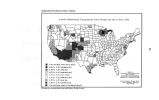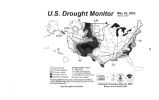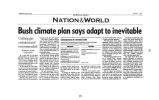| OCR Text |
Show 72 ttnitodl States Ompmrtmmat of AsricuHcmt & NRCS Natural Resources Conservation Seaviaa P. O. BOX2680 WashinBten. D, C, 20013 The Honorable Jiiii Matheson July 8, 2002 House of Representatives 410 Cannon House Office Building Washington, D, C. 20515 Dear Congressman Matheson: Thank you for your letter of June 3,2002, to Mr. Randy Inlander, noting your interest in Natural Resource Conservation Service ( NRCS) programs that assist in monitoring the risk assessment of drought The questions that you asked highlight key issues related to national drought monitoring and risk assessment. We would be pleased to provide additional mformation and explanation if needed- Question 1. What does the Natural Resources Conservation Service ( NRCS) coHtribol* to the public good in the way of drought monitoring? NRCS monitors snowpack, precipitation, and temperature in the Western United States with our automated SNOwpack TEI^ metry ( SNOTEL) system and our cooperative manual Snow Course network. Wc also have a limited number of monitoring sites in the East and Midwest, under the Soil, Climate Analysis Network ( SCAN) Initiative. We provide snowpacfc information and water supply analyses for the management of limited seasonal streamflows for irrigation and agricultural production, domestic water supplies, and drought mitigation. This information is provided free of charge to ail citizens in all media, and is Internet accessible. Web access to this information has amounted to over 1,000,000 bits per month during the winter and spring months representing some 40,000 customers. A wide range of water managers, including farmers, ranchers, dam operators, hydroelectric power plant managers, water based recreation facility managers, and flood forecasters depend on these data and products to make informed scientific water management decisions. Efficient water management ensures a dependable mod, fiber, and power supply, and minimizes the risk associated with drought and other water related problems. Question 2. What art the primary differences between drought in the mountainous areas of the West and the remainder of the United States? In the West, jfrom 80 percent to nearly all surface water supplies are derived from melting snowpack. This is significantly different than in the East and Midwest, where hydrology/ water supply is not as dependent on snow as the primary source of surface water. Since water supply in the West originates as snow, monitoring snowpack allows for advance ( 3 to 5 months) Th> Natural Resources CoruerwTtan Strvto provides icadarsWp In a panrortWp effort w rurfp people < onnrve, nuirruin. * nd Improve our natural resource* end Bflvlnwwnero. ton Equal Opportunity Provider oruf Employer |


























































































